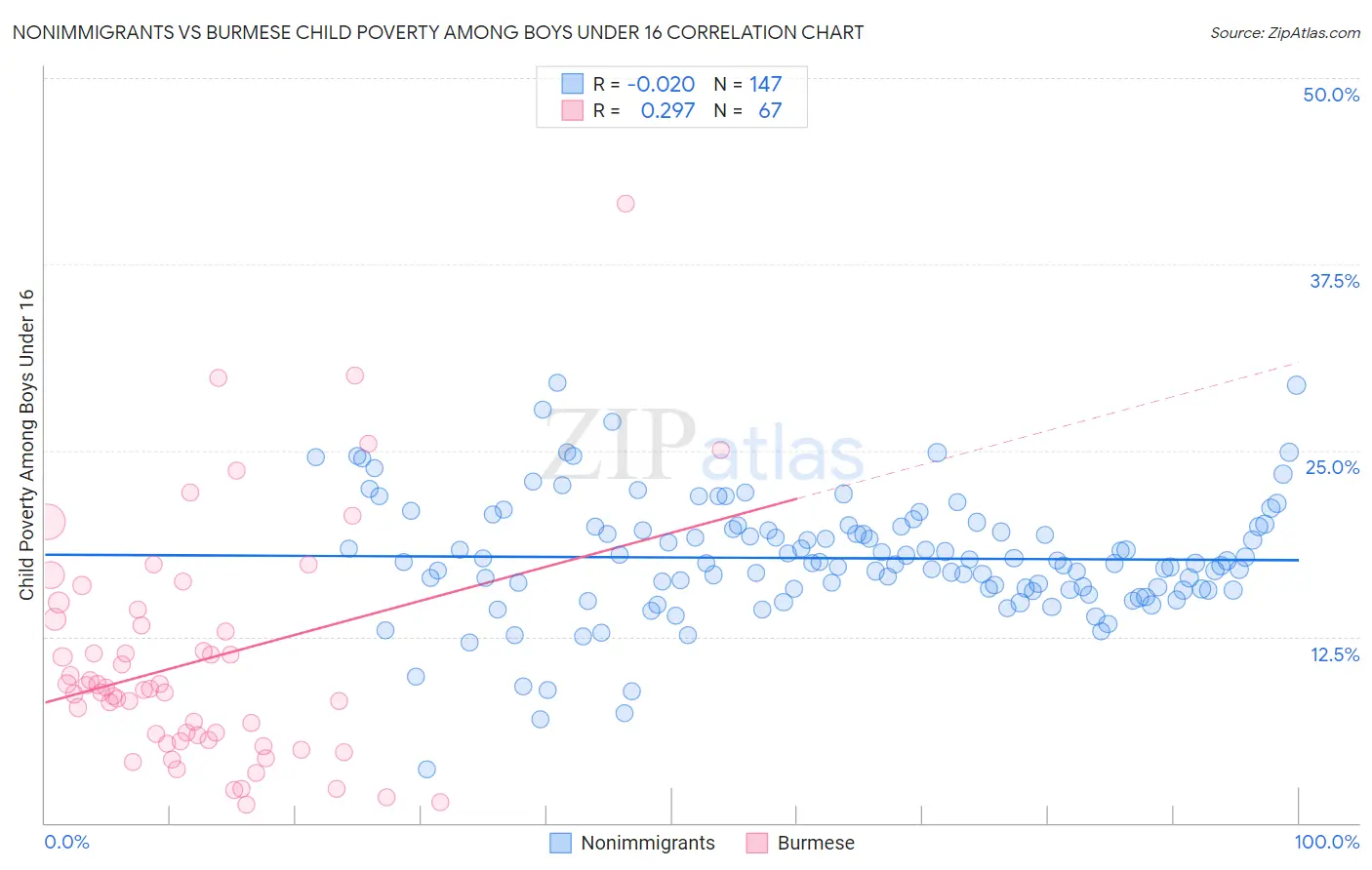Nonimmigrants vs Burmese Child Poverty Among Boys Under 16
COMPARE
Nonimmigrants
Burmese
Child Poverty Among Boys Under 16
Child Poverty Among Boys Under 16 Comparison
Nonimmigrants
Burmese
18.2%
CHILD POVERTY AMONG BOYS UNDER 16
2.2/ 100
METRIC RATING
228th/ 347
METRIC RANK
13.0%
CHILD POVERTY AMONG BOYS UNDER 16
99.9/ 100
METRIC RATING
12th/ 347
METRIC RANK
Nonimmigrants vs Burmese Child Poverty Among Boys Under 16 Correlation Chart
The statistical analysis conducted on geographies consisting of 561,195,614 people shows no correlation between the proportion of Nonimmigrants and poverty level among boys under the age of 16 in the United States with a correlation coefficient (R) of -0.020 and weighted average of 18.2%. Similarly, the statistical analysis conducted on geographies consisting of 454,977,536 people shows a weak positive correlation between the proportion of Burmese and poverty level among boys under the age of 16 in the United States with a correlation coefficient (R) of 0.297 and weighted average of 13.0%, a difference of 40.2%.

Child Poverty Among Boys Under 16 Correlation Summary
| Measurement | Nonimmigrants | Burmese |
| Minimum | 3.6% | 1.2% |
| Maximum | 29.6% | 41.5% |
| Range | 26.0% | 40.3% |
| Mean | 17.8% | 10.9% |
| Median | 17.4% | 9.0% |
| Interquartile 25% (IQ1) | 15.7% | 5.6% |
| Interquartile 75% (IQ3) | 19.9% | 13.7% |
| Interquartile Range (IQR) | 4.2% | 8.1% |
| Standard Deviation (Sample) | 4.1% | 7.7% |
| Standard Deviation (Population) | 4.0% | 7.6% |
Similar Demographics by Child Poverty Among Boys Under 16
Demographics Similar to Nonimmigrants by Child Poverty Among Boys Under 16
In terms of child poverty among boys under 16, the demographic groups most similar to Nonimmigrants are Bermudan (18.1%, a difference of 0.33%), Immigrants from Africa (18.1%, a difference of 0.43%), Immigrants from Micronesia (18.3%, a difference of 0.52%), Fijian (18.3%, a difference of 0.52%), and Inupiat (18.1%, a difference of 0.59%).
| Demographics | Rating | Rank | Child Poverty Among Boys Under 16 |
| Immigrants | Panama | 4.3 /100 | #221 | Tragic 17.9% |
| Pennsylvania Germans | 3.9 /100 | #222 | Tragic 17.9% |
| Cubans | 3.8 /100 | #223 | Tragic 17.9% |
| Nepalese | 3.2 /100 | #224 | Tragic 18.0% |
| Inupiat | 2.7 /100 | #225 | Tragic 18.1% |
| Immigrants | Africa | 2.6 /100 | #226 | Tragic 18.1% |
| Bermudans | 2.5 /100 | #227 | Tragic 18.1% |
| Immigrants | Nonimmigrants | 2.2 /100 | #228 | Tragic 18.2% |
| Immigrants | Micronesia | 1.8 /100 | #229 | Tragic 18.3% |
| Fijians | 1.8 /100 | #230 | Tragic 18.3% |
| Nicaraguans | 1.4 /100 | #231 | Tragic 18.4% |
| Marshallese | 1.3 /100 | #232 | Tragic 18.4% |
| Immigrants | Nigeria | 1.2 /100 | #233 | Tragic 18.4% |
| Nigerians | 1.1 /100 | #234 | Tragic 18.5% |
| Americans | 0.9 /100 | #235 | Tragic 18.6% |
Demographics Similar to Burmese by Child Poverty Among Boys Under 16
In terms of child poverty among boys under 16, the demographic groups most similar to Burmese are Immigrants from Korea (13.0%, a difference of 0.50%), Immigrants from Ireland (13.1%, a difference of 1.2%), Immigrants from Japan (13.1%, a difference of 1.3%), Maltese (13.2%, a difference of 1.6%), and Norwegian (13.2%, a difference of 1.7%).
| Demographics | Rating | Rank | Child Poverty Among Boys Under 16 |
| Chinese | 100.0 /100 | #5 | Exceptional 11.9% |
| Immigrants | Hong Kong | 100.0 /100 | #6 | Exceptional 12.3% |
| Iranians | 100.0 /100 | #7 | Exceptional 12.4% |
| Immigrants | Singapore | 100.0 /100 | #8 | Exceptional 12.5% |
| Immigrants | Iran | 100.0 /100 | #9 | Exceptional 12.5% |
| Bhutanese | 100.0 /100 | #10 | Exceptional 12.6% |
| Immigrants | South Central Asia | 100.0 /100 | #11 | Exceptional 12.7% |
| Burmese | 99.9 /100 | #12 | Exceptional 13.0% |
| Immigrants | Korea | 99.9 /100 | #13 | Exceptional 13.0% |
| Immigrants | Ireland | 99.9 /100 | #14 | Exceptional 13.1% |
| Immigrants | Japan | 99.9 /100 | #15 | Exceptional 13.1% |
| Maltese | 99.9 /100 | #16 | Exceptional 13.2% |
| Norwegians | 99.9 /100 | #17 | Exceptional 13.2% |
| Bulgarians | 99.9 /100 | #18 | Exceptional 13.3% |
| Bolivians | 99.9 /100 | #19 | Exceptional 13.3% |